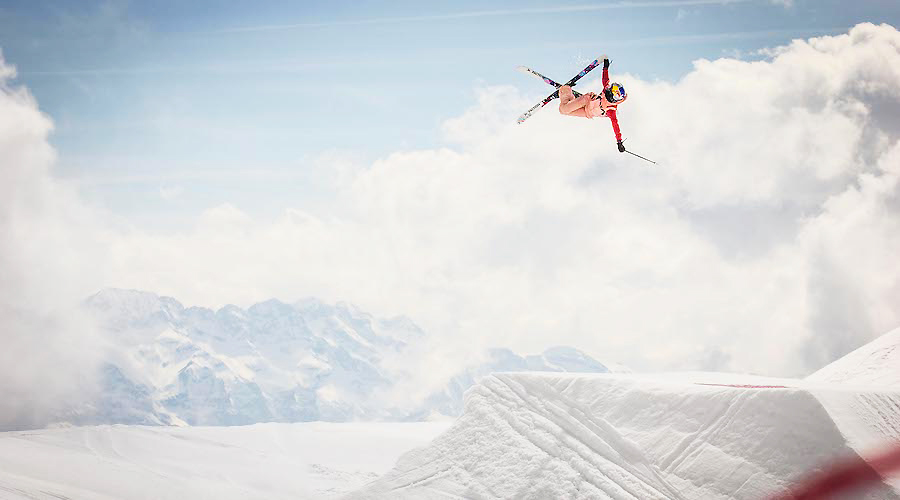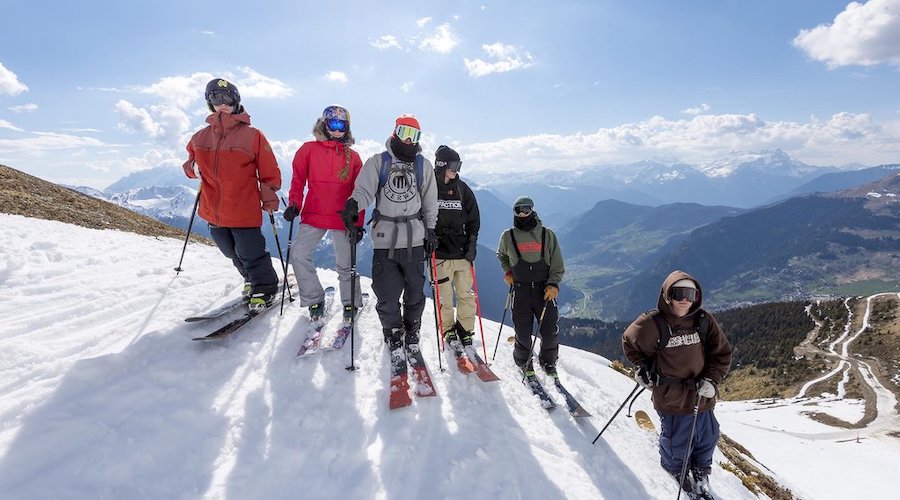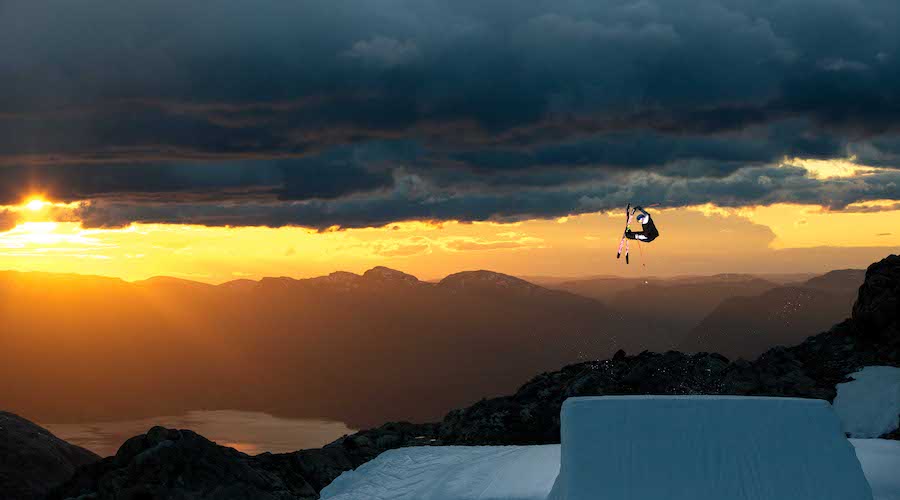By Eric Smith
<span style="color: #999999;">Aside from a dozen or so pairs of skis leaning against a wall and freshly printed product catalogs strewn about, the nondescript office at 930 Inca Street in Denver’s Santa Fe district might not look like the North American headquarters for a global ski company.
But this space, however unassuming, represents a bold statement for Faction Skis, which has transformed the building into its new U.S. outpost.
Although the freeride, freestyle and all-mountain ski manufacturer is based in Verbier, Switzerland, and much bigger in Europe than it is here, Faction has targeted this side of the Atlantic for its next growth phase. And Denver will be the hub.
Faction took over the office a couple of months ago, effectively relocating the NA operation from its previous headquarters in Breckenridge, though the company still has a presence in the mountain town.
The decision to move was easy. Denver provides more opportunities for Faction to attract talent, host sales reps, operate a showroom for visiting retailers and, in general, be more accessible to national accounts and other partners.
Once it’s fully built out, this modest space will be ground zero for Faction’s growth initiative, according to Alex Hoye, CEO of Faction and its parent company, Full Stack Supply Co. (FSSC), which also owns and operates Roxy Skis and the newly launched FW Apparel brand.
“We did a very strategic assessment and said, ‘How we how are we going to make North America all we can?’” Hoye told SGB during a recent visit to the new office. “We’ve got a long way to go, but the Denver move is one of about 30 we’re making as a business. Every company and every brand has its evolution, its story. This represents us moving to another new phase.”

The Drivers Behind Faction’s New Phase
Hoye and Tony McWilliam founded Faction Skis in 2006, and the brand grew steadily over the years, now hitting about $10 million in annual revenue, said Hoye, who calls this latest move “phase three” for the company.
In 2014, when Faction took over the global license for Roxy Skis, the duo created the holding company to better manage a growing portfolio. FSSC is privately held, with 350 stakeholders who are “fans of the business,” Hoye said. Investors include a variety of entrepreneurs, finance professionals and individuals who work in private equity, but no institutional money is involved.
As Hoye and his team look to increase value for its shareholders, they have targeted the U.S. because it’s the “biggest freeski market in the world” and ripe for growth, said Hoye, who is from the U.S. but based in London. North America composes about 28 percent of Faction’s global sales, but the “rightful place is in the low 30s,” he added.
So far, the company is on track. North America is growing around 50 percent annually, Hoye said, a similar clip as Faction’s biggest market, France. Meanwhile, countries like Austria and Germany are notching impressive 150 percent sales increases. The company’s revenue for the 2019/20 season is up 40 percent from the prior year, fueled by nine new Austrian-built ski models.
This sales bump is helping Faction grow market share at a healthy rate. Hoye said the industry statistics he’s seen show Faction makes up only about 1 percent of the ski market in North America, while in France that number is more than 2 percent and in some other markets it’s as high as 4 percent. That leaves the U.S. with plenty of room to grow.
“It’s holding its own right now,” Hoye said of this market. “We’ve got a lot of opportunity here and that’s a reflection, I think, of this inflection point in the business.”

Strategies For North America Growth
Faction is tapping into that inflection point of growing North America in a few ways. Most notably, it is scaling up production in Austria to meet what it sees as growing demand for its premium skis.
The company produces about 25 models designed for either all-mountain, backcountry, freeride, freestyle, moguls, piste or touring. About 80 percent of the company’s production is in Austria, which is up from 20 percent in 2018/19 and which will rise to 95 percent for next season.
“We’ve always produced in Europe, we always will,” Hoye said. “But we’ve also made some big moves in our product development.” For example, the company’s factory has better access to raw materials, Hoye noted, so even though the price is going down, the quality is going up.
Another big move is bringing more sales in-house and moving away from independent reps. Last year Faction brought Colorado, Utah and the East Coast in-house, and this year the company will do the same for the Pacific Northwest and Western Canada, all with the goal of providing better service to the company’s specialty accounts.
As for Faction’s channel strategy, the brand is in more than 600 doors, and while getting in more doors is paramount for any brand looking to grow, much of the focus is growing the number of SKUs in those doors—say, going from two to four or five to match the number of Atomics or Rossignols or Salomons or other brands fighting for mind share.
While the company sees direct-to-consumer as a way to both grow revenue and, of course, increase margins, Faction values its channel partners and doesn’t see its website taking significant business from key snow specialty accounts. Hoye said direct is only around 10 percent of total sales as the company prioritizes retail.
“I’m a big protagonist for our retail partners,” he said. “The skis are such a consultative sell, and we still want every interaction to be special. That’s important, whether they buy from us or through a retail channel. If we can offer a better experience than a particular retail partner, we want to do that. But we usually can’t, frankly. They’re going to want to mount it and get the other services, and that’s fine.”
Growing North America also means having an office in a metro area that many people consider the heart of the snow industry. Denver, of course, is the home of the annual Snow Show and headquarters for other ski brands.
Lastly, the growth strategy means putting more boots on the ground, namely people like veteran sales executive Ryan Guay, who joined FSSC as NA head of sales development, and former Freeskier Magazine editor-in-chief Henrik “Hank” Lampert, who joined the company as NA marketing manager.
Bringing Guay and Lampert was a coup for the brand, said Hoye, proof that moving to Denver had already paid off. For Lampert, who has long skied Faction and, of course, wrote about the company while at Freeskier, the decision to join this company, in particular, was a no-brainer.
“If I could have my pick of any manufacturer to work for, this would be the one—every time,” said Lampert, a former professional skier and one-time collegiate national champion in slopestyle skiing. “It’s got the most energy and it’s small enough to be very nimble. Truly this team is special.”

Forward-Thinking Apparel
That energy and nimbleness have led FSSC to relaunch an apparel offering, albeit one that differs from the previous line it ran under the Faction name. The company recently announced its new FW (pronounced “forward”) Apparel brand, which is being spearheaded by Olivier Gouby.
“It’s a very strategic move,” Hoye said. “We ran the Faction apparel division for three years. We made good product that was high quality, but what we realized was the people who were buying the apparel were buying it mostly because they were Faction fans. We weren’t getting outside of the core fans.”
The company scrapped its original apparel division and spent a couple of years developing a new line that was “comparable to our skis in terms of innovation and style and impact,” Hoye said. But when the first effort wasn’t good enough, they took additional time to make it just right.
“We put another year of R&D into it,” Hoye said. “We went to all the big designers, the ones that design for some of the big names out there but also ones that focused on materials. We went to Japan, to Taiwan to China to Portugal to Estonia, looked at all these factories, looked at all the trends that were happening.”
FSSC, which launched the FW brand with a few SKUs in men’s outerwear, has sold product into 14 countries in year one with pretty much no marketing yet, Hoye said. FW will debut women’s apparel for the 2020/21 season in hopes of growing the brand, but only through sustainable expansion.
“We would like to see in four to five years through an ambitious but organic process, FW becoming that progressive, quality brand that infuses the Alps where we’ve come from, but also has that scope to cross to other exploration campaigns,” Hoye said. That means moving into such categories as surf, which would be a nod to Hoye’s snowboarding past.
While FW Apparel will be pricier than competing brands—just as Faction’s skis are—Hoye sees the product gaining fans in the same way too.
“People can buy their basics anywhere, and that leaves headspace and excitement to buy things that are special,” he said. “And whatever income level they’re at, if they’re excited about something, they’re going to buy that thing that’s more special.”

Growing The Fanbase
Faction, along with its sister brands FW and Roxy Skis, has a different view of its relationship with customers, which the company instead calls “fans.” After all, Hoye said, “no one ‘consumes’ skis.”
One important way the brand connects with its fans is though the annual ski films it produces. Faction films have hundreds of screenings and thousands of viewers globally.
This year’s film, currently on tour, is called “The Collective,” a nod to the moniker Faction bestows on its community of “skiers, artists, film-makers, staff, partners and fans that has grown over the past 12 years, who are united by a love for the mountains, and the tools that allow us to escape there.”
That attitude, embodied by such Faction skiers as Candid Thovex and others, is as important to Faction as the skis it makes, Hoye said.
“It’s very important that we have a relationship with our fans,” he said. “That relationship is heavily in Hank’s hands with marketing, and the marketing is about getting people excited about the product through the stories that we tell.”
As Faction moves into the next phase, Hoye is steadfast about keeping the storyline consistent. That includes not taking on institutional investors or venture capital or private equity stakes, despite growing outside interest. Why risk ruining the grassroots vibe that Faction has built all these years?
“Imagine taking the ball down the field from your own end zone to the 2-yard line—(expletive) no,” Hoye said with a laugh. “We’re going to do it with the people who took us there. We’re backed by angel investors to the tune of over $10 million. It’s been a special journey. We’re going to deliver for them, but we’re going to do it by creating great products and a valuable company and not to flip it to some private equity firm.”
While Hoye and his team would consider acquiring another brand—and a few deals nearly happened before fizzling—that would happen only if it’s both strategic and opportunistic. In other words, don’t look for FSSC to bolt on a new business merely for the sake of growing.
As it stands, business is humming. Faction is pleased with both the growth trajectory it’s seen since launching and what it’s projecting moving forward. And the brand is especially stoked because it has stayed true to its freeride, freeski and all-mountain roots.
“We’re hitting pretty good metrics,” Hoye said. “I’ve got to admit that as I look at some lost opportunities, I think we could have been a little bit bigger sooner. But on the other hand, we have to keep our spirit and keep things our way.”
Photos courtesy Faction Skis
















